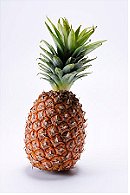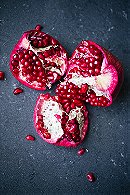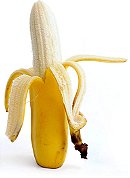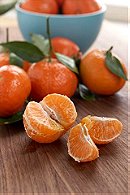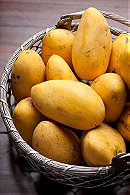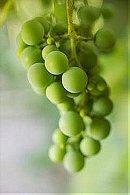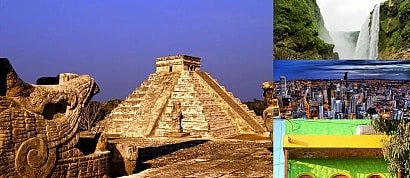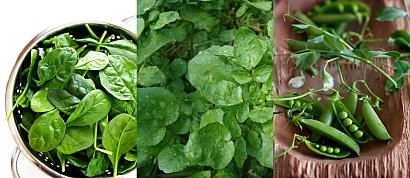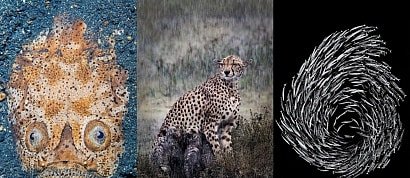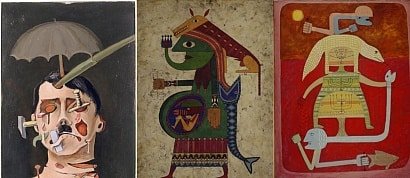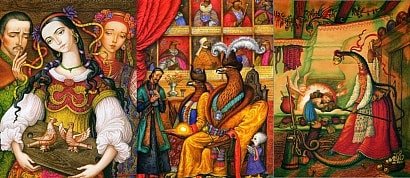My favorite Fruits
Sort by:
Showing 10 items
Rating:
List Type:
 Add items to section
Add items to section
Fruits
The first garden strawberry was grown in Brittany, France during the late 18th century. Prior to this, wild strawberries and cultivated selections from wild strawberry species were the common source of the fruit.
The strawberry fruit was mentioned in ancient Roman literature in reference to its medicinal use. The French began taking the strawberry from the forest to their gardens for harvest in the 14th century. Charles V, France's king from 1364 to 1380, had 1,200 strawberry plants in his royal garden. In the early 15th century western European monks were using the wild strawberry in their illuminated manuscripts. The strawberry is found in Italian, Flemish, and German art, and in English miniatures.[citation needed] The entire strawberry plant was used to treat depressive illnesses.
By the 16th century references of cultivation of the strawberry became more common. People began using it for its supposed medicinal properties and botanists began naming the different species. In England the demand for regular strawberry farming had increased by the mid-16th century. The combination of strawberries and cream was created by Thomas Wolsey in the court of King Henry VIII. Instructions for growing and harvesting strawberries showed up in writing in 1578. By the end of the 16th century three European species had been cited: F. vesca, F. moschata, and F. viridis. The garden strawberry was transplanted from the forests and then the plants would be propagated asexually by cutting off the runners.
Two subspecies of F. vesca were identified: F. sylvestris alba and F. sylvestris semperflorens. The introduction of F. virginiana from Eastern North America to Europe in the 17th century is an important part of history because this species gave rise to the modern strawberry. The new species gradually spread through the continent and did not become completely appreciated until the end of the 18th century. When a French excursion journeyed to Chile in 1712, it introduced the strawberry plant with female flowers that resulted in the common strawberry that we have today.
The Mapuche and Huilliche Indians of Chile cultivated the female strawberry species until 1551 when the Spanish came to conquer the land. In 1765, a European explorer recorded the cultivation of F. chiloensis, the Chilean strawberry. At first introduction to Europe, the plants grew vigorously but produced no fruit. It was discovered in 1766 that the female plants could only be pollinated by plants that produced large fruit: F. moschata, F. virginiana, and F. ananassa. This is when the Europeans became aware that plants had the ability to produce male-only or female-only flowers. As more large-fruit producing plants were cultivated the Chilean strawberry slowly decreased in population in Europe, except for around Brest where the Chilean strawberry thrived. The decline of the Chilean strawberry was caused by F. ananassa.

Hieronymus Bosch - The Garden of Earthly Delights, central panel - Detai Man eating a strawberry, Man eating a cherry, and a man bending over a fictional fruit.
The strawberry fruit was mentioned in ancient Roman literature in reference to its medicinal use. The French began taking the strawberry from the forest to their gardens for harvest in the 14th century. Charles V, France's king from 1364 to 1380, had 1,200 strawberry plants in his royal garden. In the early 15th century western European monks were using the wild strawberry in their illuminated manuscripts. The strawberry is found in Italian, Flemish, and German art, and in English miniatures.[citation needed] The entire strawberry plant was used to treat depressive illnesses.
By the 16th century references of cultivation of the strawberry became more common. People began using it for its supposed medicinal properties and botanists began naming the different species. In England the demand for regular strawberry farming had increased by the mid-16th century. The combination of strawberries and cream was created by Thomas Wolsey in the court of King Henry VIII. Instructions for growing and harvesting strawberries showed up in writing in 1578. By the end of the 16th century three European species had been cited: F. vesca, F. moschata, and F. viridis. The garden strawberry was transplanted from the forests and then the plants would be propagated asexually by cutting off the runners.
Two subspecies of F. vesca were identified: F. sylvestris alba and F. sylvestris semperflorens. The introduction of F. virginiana from Eastern North America to Europe in the 17th century is an important part of history because this species gave rise to the modern strawberry. The new species gradually spread through the continent and did not become completely appreciated until the end of the 18th century. When a French excursion journeyed to Chile in 1712, it introduced the strawberry plant with female flowers that resulted in the common strawberry that we have today.
The Mapuche and Huilliche Indians of Chile cultivated the female strawberry species until 1551 when the Spanish came to conquer the land. In 1765, a European explorer recorded the cultivation of F. chiloensis, the Chilean strawberry. At first introduction to Europe, the plants grew vigorously but produced no fruit. It was discovered in 1766 that the female plants could only be pollinated by plants that produced large fruit: F. moschata, F. virginiana, and F. ananassa. This is when the Europeans became aware that plants had the ability to produce male-only or female-only flowers. As more large-fruit producing plants were cultivated the Chilean strawberry slowly decreased in population in Europe, except for around Brest where the Chilean strawberry thrived. The decline of the Chilean strawberry was caused by F. ananassa.

Hieronymus Bosch - The Garden of Earthly Delights, central panel - Detai Man eating a strawberry, Man eating a cherry, and a man bending over a fictional fruit.
The watermelon is thought to have originated in southern Africa, where it is found growing wild. It reaches maximum genetic diversity there, with sweet, bland and bitter forms. In the 19th century, Alphonse de Candolle considered the watermelon to be indigenous to tropical Africa. Citrullus colocynthis is often considered to be a wild ancestor of the watermelon and is now found native in north and west Africa. However, it has been suggested on the basis of chloroplast DNA investigations, that the cultivated and wild watermelon diverged independently from a common ancestor, possibly C. ecirrhosus from Namibia.
Evidence of its cultivation in the Nile Valley has been found from the second millennium BC onward. Watermelon seeds have been found at Twelfth Dynasty sites and in the tomb of Pharaoh Tutankhamun.
In the 7th century, watermelons were being cultivated in India and by the 10th century had reached China, which is today the world's single largest watermelon producer. Moorish invaders introduced the fruit into Europe and there is evidence of it being cultivated in Córdoba in 961 and also in Seville in 1158. It spread northwards through southern Europe, perhaps limited in its advance by summer temperatures being insufficient for good yields. The fruit had begun appearing in European herbals by 1600, and was widely planted in Europe in the 17th century as a minor garden crop.
European colonists and slaves from Africa introduced the watermelon into the New World. Spanish settlers were growing it in Florida in 1576, and it was being grown in Massachusetts by 1629, and by 1650 was being cultivated in Peru, Brazil and Panama as well as in many British and Dutch colonies. Around the same time, Native Americans were cultivating the crop in the Mississippi valley and Florida. Watermelons were rapidly accepted in Hawaii and other Pacific islands when they were introduced there by explorers such as Captain James Cook.

Raphaelle Peale - Melons and Morning Glories - 1813
Evidence of its cultivation in the Nile Valley has been found from the second millennium BC onward. Watermelon seeds have been found at Twelfth Dynasty sites and in the tomb of Pharaoh Tutankhamun.
In the 7th century, watermelons were being cultivated in India and by the 10th century had reached China, which is today the world's single largest watermelon producer. Moorish invaders introduced the fruit into Europe and there is evidence of it being cultivated in Córdoba in 961 and also in Seville in 1158. It spread northwards through southern Europe, perhaps limited in its advance by summer temperatures being insufficient for good yields. The fruit had begun appearing in European herbals by 1600, and was widely planted in Europe in the 17th century as a minor garden crop.
European colonists and slaves from Africa introduced the watermelon into the New World. Spanish settlers were growing it in Florida in 1576, and it was being grown in Massachusetts by 1629, and by 1650 was being cultivated in Peru, Brazil and Panama as well as in many British and Dutch colonies. Around the same time, Native Americans were cultivating the crop in the Mississippi valley and Florida. Watermelons were rapidly accepted in Hawaii and other Pacific islands when they were introduced there by explorers such as Captain James Cook.

Raphaelle Peale - Melons and Morning Glories - 1813
Pomegranate is native to a region from Iran to northern India. Pomegranates have been cultivated throughout the Middle East, South Asia, and Mediterranean region for several millennia, and also thrive in the drier climates of California and Arizona.
Carbonized exocarp of the fruit has been identified in early Bronze Age levels of Jericho in the West Bank, as well as late Bronze Age levels of Hala Sultan Tekke on Cyprus and Tiryns.[citation needed] A large, dry pomegranate was found in the tomb of Djehuty, the butler of Queen Hatshepsut in Egypt; Mesopotamian cuneiform records mention pomegranates from the mid-third millennium BC onwards.
It is also extensively grown in South China and in Southeast Asia, whether originally spread along the route of the Silk Road or brought by sea traders. Kandahar is famous in Afghanistan for its high-quality pomegranates.[citation needed]
Although not native to Korea or Japan, the pomegranate is widely grown there and many cultivars have been developed. It is widely used for bonsai because of its flowers and for the unusual twisted bark the older specimens can attain. The term "balaustine" (Latin: balaustinus) is also used for a pomegranate-red color.
Spanish colonists later introduced the fruit to the Caribbean and America (Spanish America), but in the English colonies, it was less at home: "Don't use the pomegranate inhospitably, a stranger that has come so far to pay his respects to thee," the English Quaker Peter Collinson wrote to the botanizing John Bartram in Philadelphia, 1762. "Plant it against the side of thy house, nail it close to the wall. In this manner it thrives wonderfully with us, and flowers beautifully, and bears fruit this hot year. I have twenty-four on one tree... Doctor Fothergill says, of all trees this is most salutiferous to mankind."
The pomegranate had been introduced as an exotic to England the previous century, by John Tradescant the elder, but the disappointment that it did not set fruit there led to its repeated introduction to the American colonies, even New England. It succeeded in the South: Bartram received a barrel of pomegranates and oranges from a correspondent in Charleston, South Carolina, 1764. John Bartram partook of "delitious" pomegranates with Noble Jones at Wormsloe Plantation, near Savannah, Georgia, in September 1765. Thomas Jefferson planted pomegranates at Monticello in 1771: he had them from George Wythe of Williamsburg.

Sandro Botticelli - Madonna della melagrana, detail - 1487
Carbonized exocarp of the fruit has been identified in early Bronze Age levels of Jericho in the West Bank, as well as late Bronze Age levels of Hala Sultan Tekke on Cyprus and Tiryns.[citation needed] A large, dry pomegranate was found in the tomb of Djehuty, the butler of Queen Hatshepsut in Egypt; Mesopotamian cuneiform records mention pomegranates from the mid-third millennium BC onwards.
It is also extensively grown in South China and in Southeast Asia, whether originally spread along the route of the Silk Road or brought by sea traders. Kandahar is famous in Afghanistan for its high-quality pomegranates.[citation needed]
Although not native to Korea or Japan, the pomegranate is widely grown there and many cultivars have been developed. It is widely used for bonsai because of its flowers and for the unusual twisted bark the older specimens can attain. The term "balaustine" (Latin: balaustinus) is also used for a pomegranate-red color.
Spanish colonists later introduced the fruit to the Caribbean and America (Spanish America), but in the English colonies, it was less at home: "Don't use the pomegranate inhospitably, a stranger that has come so far to pay his respects to thee," the English Quaker Peter Collinson wrote to the botanizing John Bartram in Philadelphia, 1762. "Plant it against the side of thy house, nail it close to the wall. In this manner it thrives wonderfully with us, and flowers beautifully, and bears fruit this hot year. I have twenty-four on one tree... Doctor Fothergill says, of all trees this is most salutiferous to mankind."
The pomegranate had been introduced as an exotic to England the previous century, by John Tradescant the elder, but the disappointment that it did not set fruit there led to its repeated introduction to the American colonies, even New England. It succeeded in the South: Bartram received a barrel of pomegranates and oranges from a correspondent in Charleston, South Carolina, 1764. John Bartram partook of "delitious" pomegranates with Noble Jones at Wormsloe Plantation, near Savannah, Georgia, in September 1765. Thomas Jefferson planted pomegranates at Monticello in 1771: he had them from George Wythe of Williamsburg.

Sandro Botticelli - Madonna della melagrana, detail - 1487
Kiwifruit is native to north-central and eastern China. Cultivation of the fuzzy kiwifruit spread from China in the early 20th century to New Zealand, where the first commercial plantings occurred. Although kiwifruit is a national fruit of China, until recently, China was not a major producing country of kiwifruit, as it was traditionally collected from the wild.[9] The fruit became popular with American servicemen stationed in New Zealand during World War II and later exported to California using the names "Chinese gooseberry" and "melonette". In 1962, New Zealand growers began calling it "kiwifruit" to give it more market appeal, and a California-based importer subsequently used that name when introducing the fruit to the American market.

Denis Chernov – Still Life with Flowers – Beautiful drawing of an internet artist, dated to 2003.

Denis Chernov – Still Life with Flowers – Beautiful drawing of an internet artist, dated to 2003.
Mandarin oranges are native to the tropical and sub-tropical regions of Asia, probably Southern China, the Philippines and the Malay Archipelago. There are many different hybrids or varieties of Mandarins. The flavour of the fruit ranges from sprightly sweet to nearly spicy. Some are seedless while others full of them. The fruits also vary in size and colour. Tangerines, for example, are the brightly-coloured version of Mandarins.
Due to the great variety, there were probably differences in the early classification of the fruits, resulting in other scientific names for Mandarin oranges like Citrus nobilis, Citrus deliciosa and Citrus chrysocarpa. The most distinctive feature of all Mandarin oranges is its peelable skin. The fruits of Citrus reticulata have a very loose skin that is so easy to peel that they are called kid-glove or loose-skin oranges.
Mandarin oranges were nearly restricted to Asia until their introduction to the West at the turn of the 19th century. In 1805, two varieties of the Mandarin oranges were brought into England from Canton. From England, it was introduced into the Mediterranean region. By 1850, the fruit was well-established in Italy. The Italian Consul at New Orleans in the United states imported Mandarin oranges from Italy between 1840 to 1850. From there the fruit spread to Florida and later to California. In 1896, a variety of the fruit from Japan, the Owari Satsuma, was introduced to USA, and between 1908 and 1911, about a million budded trees of the same variety were sent to the Gulf for planting. Another variety of the fruit, the King Mandarin, was sent from Saigon to California in 1882. In 1888, seeds of Oneco Mandarin which were widely grown in the Western Ghats of India were sent to the USA. In the early 1890s, the Ponkan variety were sent to the USA from China, and this led to the commercial propagation of Mandarins in the USA.
The fruit was probably named "Mandarin" because it was introduced to the West by China. "Mandarin" was an English reference for Chinese government officials. The fruit is also known as Mandarina among the Spanish-speaking population of the American tropics. Mandarin oranges today are commonly found in Japan, East Indies, India, Australia and almost all tropical, sub-tropical and cooler parts of the world. In Southeast Asia, the Citrus reticulata and Citrus sinensis varieties are commercially grown in the cooler Cameron Highlands of Peninsular Malaysia. Citrus suhuiensis, known as limau langkat or limau madu in Malay, is grown in the warmer Malaysian states of Terengganu, Johor and Pahang.

Maxime Dastugue - "Fille avec des mandarins" ("Girl with Tangerines")
Due to the great variety, there were probably differences in the early classification of the fruits, resulting in other scientific names for Mandarin oranges like Citrus nobilis, Citrus deliciosa and Citrus chrysocarpa. The most distinctive feature of all Mandarin oranges is its peelable skin. The fruits of Citrus reticulata have a very loose skin that is so easy to peel that they are called kid-glove or loose-skin oranges.
Mandarin oranges were nearly restricted to Asia until their introduction to the West at the turn of the 19th century. In 1805, two varieties of the Mandarin oranges were brought into England from Canton. From England, it was introduced into the Mediterranean region. By 1850, the fruit was well-established in Italy. The Italian Consul at New Orleans in the United states imported Mandarin oranges from Italy between 1840 to 1850. From there the fruit spread to Florida and later to California. In 1896, a variety of the fruit from Japan, the Owari Satsuma, was introduced to USA, and between 1908 and 1911, about a million budded trees of the same variety were sent to the Gulf for planting. Another variety of the fruit, the King Mandarin, was sent from Saigon to California in 1882. In 1888, seeds of Oneco Mandarin which were widely grown in the Western Ghats of India were sent to the USA. In the early 1890s, the Ponkan variety were sent to the USA from China, and this led to the commercial propagation of Mandarins in the USA.
The fruit was probably named "Mandarin" because it was introduced to the West by China. "Mandarin" was an English reference for Chinese government officials. The fruit is also known as Mandarina among the Spanish-speaking population of the American tropics. Mandarin oranges today are commonly found in Japan, East Indies, India, Australia and almost all tropical, sub-tropical and cooler parts of the world. In Southeast Asia, the Citrus reticulata and Citrus sinensis varieties are commercially grown in the cooler Cameron Highlands of Peninsular Malaysia. Citrus suhuiensis, known as limau langkat or limau madu in Malay, is grown in the warmer Malaysian states of Terengganu, Johor and Pahang.

Maxime Dastugue - "Fille avec des mandarins" ("Girl with Tangerines")
The mango has been known in India since very early times. It is referred to in Sanskrit literature as Amra and has been under cultivation by man for over 4000 years.
It appears, however, that Hsiian-tsang, one of the early travelers to India (632-645), was the first person to bring mango to the notice of people outside India.
This fruit occupied an important place in horticulture during the rule of the Mogul emperors in India, and Akbar the Great (1556-1605) planted an orchard of 100,000 mango trees.
The origin of most o the improved varieties in India have been traced to those days, and the encyclopedia Ain-e-Akbari (1590 AD) contains a good account of the mango regarding its quality and varietal characteristics.
Phytogeographical data studies of the phylogenetic taxonomy of species of Mangifera indicate that this genus originated in the Indo-Burma region.
Most of the cultivated varieties have arisen from four main species – Mangifera indica, Mangifera sylvatica, Mangifera odorata, and Mangifera zeylanica.
Mango cultivation is found in many countries of Southeast Asia – the Philippines, Indonesia, Java, Thailand, Burma, Malaysia and Sri Lanka.
Introduction of the mango to East and West Africa and subsequently to Brazil is said to have occurred in the sixteenth century.
Mexico acquired the mango in the nineteenth century, and it entered Florida in 1833. The cultivated mango varieties are the result of constant selection by man from original wild plants for over 4000 years.
The wild progenies are still available in India in two species, Mangifera indica and Mangifera sylvatica, which have small fruits with a big stone, thin acidic flesh and long fibers.

Vahine No Te Vi Aka Woman With A Mango - Paul Gauguin - 1892
It appears, however, that Hsiian-tsang, one of the early travelers to India (632-645), was the first person to bring mango to the notice of people outside India.
This fruit occupied an important place in horticulture during the rule of the Mogul emperors in India, and Akbar the Great (1556-1605) planted an orchard of 100,000 mango trees.
The origin of most o the improved varieties in India have been traced to those days, and the encyclopedia Ain-e-Akbari (1590 AD) contains a good account of the mango regarding its quality and varietal characteristics.
Phytogeographical data studies of the phylogenetic taxonomy of species of Mangifera indicate that this genus originated in the Indo-Burma region.
Most of the cultivated varieties have arisen from four main species – Mangifera indica, Mangifera sylvatica, Mangifera odorata, and Mangifera zeylanica.
Mango cultivation is found in many countries of Southeast Asia – the Philippines, Indonesia, Java, Thailand, Burma, Malaysia and Sri Lanka.
Introduction of the mango to East and West Africa and subsequently to Brazil is said to have occurred in the sixteenth century.
Mexico acquired the mango in the nineteenth century, and it entered Florida in 1833. The cultivated mango varieties are the result of constant selection by man from original wild plants for over 4000 years.
The wild progenies are still available in India in two species, Mangifera indica and Mangifera sylvatica, which have small fruits with a big stone, thin acidic flesh and long fibers.

Vahine No Te Vi Aka Woman With A Mango - Paul Gauguin - 1892
Archeological evidence suggests humans began growing grapes as early as 6500 B.C. during the Neolithic era. By 4000 B.C., grape growing extended from Transcaucasia to Asia Minor and through the Nile Delta of Egypt. King Hammurabi of Babylon probably enacted the world’s first liquor law when he established rules for wine trade in 1700 B.C.
The Hittites are credited with spreading grape culture westward as they migrated to Crete, Bosporus and Thrace, as early as 3000 B.C. Later, the Greeks and Phoenicians extended grape growing to Carthage, Sicily, southern Italy, Spain and France. Under the influence of the Romans, grape production spread throughout Europe.
At the time of the fall of the Roman Empire, grape culture and wine making primarily were associated with monasteries. Later, the use of wine extended beyond religious rites and became entrenched in culture as a social custom. This increased demand for grapes, and grape culture grew steadily from the 16th to the 20th century.

François Boucher French - Are They Thinking about the Grape? (Pensent-ils au raisin?) - 1747
The Hittites are credited with spreading grape culture westward as they migrated to Crete, Bosporus and Thrace, as early as 3000 B.C. Later, the Greeks and Phoenicians extended grape growing to Carthage, Sicily, southern Italy, Spain and France. Under the influence of the Romans, grape production spread throughout Europe.
At the time of the fall of the Roman Empire, grape culture and wine making primarily were associated with monasteries. Later, the use of wine extended beyond religious rites and became entrenched in culture as a social custom. This increased demand for grapes, and grape culture grew steadily from the 16th to the 20th century.

François Boucher French - Are They Thinking about the Grape? (Pensent-ils au raisin?) - 1747
People who voted for this also voted for
Film Diary of 2023
15 Black Girls We Loved Watching On TV In The '90s
OTOÑO
MEXICO
Lion Cakes
ITALIA
Food & Drinks...Healthiest Vegetables You Can Eat
GRECIA
Movies RE-Watched in 2018
Owl Cakes
Hedgehog Cakes #2
Love to Visit - Can't Afford to Live There
Renée Simonsen (80s-supermodel)
Aoshima - Cat Island.
Animals
More lists from Nusch
Modern Adaptations of Greek Dramas
ART | Andrey Remnev
Favorite Spontaneous Photos
ART | Victor Brauner
Art Nouveau | architecture and design
ART | Katerina Shtanko
ART | Carl Larsson
 Login
Login

 13
13
 9.8
9.8
 0
0

